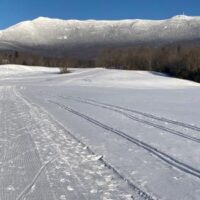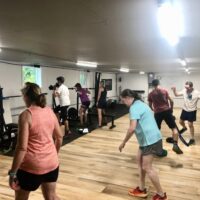We gathered at our collegiate training camp this summer in Bethel and laughed a bit about MNC University being the strongest collection of college skiers in the country. The dream was shared to one day start a pro team, with this group as the genesis once they finish their NCAA skiing and think about the next stage…
Turns out, this group may be stronger than anyone realized. Instead of just the best collegiate team in the country, this past week’s US National Championships stamped the MNC U skiers as arguably the strongest collective in the entire country.
Skiers training under the tutelage of Coach Brandon Herhusky this summer and racing at Nats include US NATIONAL CHAMPION Haley Brewster, as well as top-10 skiers Shea Brams and Ava Thurston. Oh, and top-15 skier Keelan Durham, not to mention top Junior/U23 skiers Hattie Barker, Annie McColgan, Amelia Tucker, and Libby Tuttle. Throw Devin Wong and Emma Page and Rose Clayton, and Aidan Burt in there, and the field with MNC connections at this year’s US Nationals was shockingly strong.

McColgan (UVM), Brewster (UVM), and Durham (WIL). Haley Brewster is NATIONAL CHAMP…not age group champ, or junior champ…the actual United States National Champion..!
What does the future hold for this group of National- and International-caliber athletes? When discussing the potential of a pro team, a lot of great points came up regarding the stress and isolation of living the life of a pro skier. Training hard all year, travelling around the country to race events and balancing qualifications and championship events with expenses and burnout can be tough.
Several among the MNC U group are connected enough to know/see athletes that have “gone pro” and struggled with the lifestyle. What’s different about MNC? Our location in Burlington could be a great home for skiers, keeping energy levels high and balancing the “grind” of ski training with other passions and engagements. In addition, the self-awareness of this group, their camaraderie, and their shared vision could form a different kind of model than current pro ski teams; one that is sustainable and motivational.

Shea and Haley skiing in the lead pack of the mass start, in 3rd and 4th position at this point. Haley, Shea, and Ava would go on to finish 1st, 7th, and 9th.
It’s a great time to be an American skier right now, with our nation hitting highs and showing depth we used to only imagine. As a club, MNC provides support for BKL, Juniors, and Masters athletes, but MNC U is currently our only offering for college-age (and beyond) athletes.
What could it be like to have an MNC Pro team, with athletes striving toward national and international goals like we’ve never experienced? What could that show the ski community about having fun and working hard? It would be really cool to find out!







